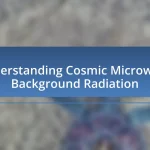The Cosmic Web is the large-scale structure of the Universe, characterized by a vast network of galaxies, galaxy clusters, and dark matter filaments. This article explores the significance of the Cosmic Web in shaping the distribution of matter and the evolution of galaxies, highlighting the role of dark matter, which constitutes approximately 80% of the Universe’s mass. Key components such as filaments, nodes, and voids are examined, along with their influence on galaxy formation and cosmic dynamics. The article also discusses observational techniques, technological advancements, and the implications of understanding the Cosmic Web for cosmology and humanity’s place in the Universe.

What is the Cosmic Web and its significance in the Universe?
The Cosmic Web is the large-scale structure of the Universe, consisting of a vast network of galaxies, galaxy clusters, and dark matter filaments that form a web-like pattern. This structure is significant because it influences the distribution of matter and the evolution of galaxies, shaping the overall dynamics of the Universe. Observations from the Sloan Digital Sky Survey and simulations of cosmic evolution reveal that approximately 80% of the Universe’s mass is in the form of dark matter, which plays a crucial role in forming the Cosmic Web. The interconnectedness of galaxies within this web affects gravitational interactions and the flow of cosmic gas, ultimately impacting star formation and the lifecycle of galaxies.
How is the Cosmic Web structured?
The Cosmic Web is structured as a vast network of interconnected filaments composed of dark matter and galaxies. These filaments form a web-like pattern, with dense regions known as nodes where galaxies cluster, and voids that are relatively empty spaces between these structures. Observations from large-scale surveys, such as the Sloan Digital Sky Survey, reveal that approximately 80% of the universe’s mass is in the form of dark matter, which plays a crucial role in shaping this web-like structure through gravitational interactions.
What are the main components of the Cosmic Web?
The main components of the Cosmic Web are galaxies, dark matter, and intergalactic gas. Galaxies are the fundamental building blocks, forming clusters and superclusters that are interconnected. Dark matter, which constitutes about 27% of the universe, provides the gravitational framework that shapes the Cosmic Web, influencing the distribution of galaxies. Intergalactic gas, primarily hydrogen, fills the voids between galaxies and clusters, contributing to the overall structure and evolution of the universe. These components collectively create a vast, intricate network that defines the large-scale structure of the cosmos.
How do galaxies and dark matter relate within the Cosmic Web?
Galaxies and dark matter are intrinsically linked within the Cosmic Web, as dark matter provides the gravitational scaffolding that shapes the large-scale structure of the universe, including the formation and distribution of galaxies. Observations indicate that dark matter constitutes approximately 27% of the universe’s total mass-energy content, influencing the clustering of galaxies and the formation of galaxy clusters along filaments of dark matter. This relationship is evidenced by gravitational lensing studies, which show how dark matter’s presence bends light from distant galaxies, revealing its distribution and confirming its role in galaxy formation and evolution.
Why is understanding the Cosmic Web important for cosmology?
Understanding the Cosmic Web is crucial for cosmology because it reveals the large-scale structure of the universe, including how galaxies are distributed and interact. The Cosmic Web consists of filaments of dark matter and gas that shape the formation and evolution of galaxies, influencing their properties and behaviors. Research indicates that approximately 80% of the universe’s mass is in the form of dark matter, which forms these filaments, guiding the formation of visible matter. This understanding helps cosmologists develop accurate models of cosmic evolution and the universe’s fate, as evidenced by studies such as the Sloan Digital Sky Survey, which maps the distribution of galaxies and provides insights into the underlying structure of the universe.
What insights does the Cosmic Web provide about the formation of the Universe?
The Cosmic Web reveals that the Universe’s large-scale structure is formed through the gravitational attraction of dark matter, leading to the creation of filaments and voids. This structure indicates that galaxies are not distributed randomly but are instead concentrated along these filaments, which serve as the scaffolding for galaxy formation. Observations from the Sloan Digital Sky Survey and simulations of cosmic evolution support this understanding, showing that the Cosmic Web’s topology influences the distribution of matter and the growth of galaxies over time.
How does the Cosmic Web influence our understanding of dark energy?
The Cosmic Web influences our understanding of dark energy by providing a framework for observing the large-scale structure of the universe, which reveals how galaxies are distributed and how they interact with dark energy. This structure, characterized by filaments and voids, helps scientists analyze the expansion rate of the universe and the effects of dark energy on cosmic evolution. Observations from the Sloan Digital Sky Survey indicate that the distribution of galaxies aligns with predictions made by dark energy models, suggesting that dark energy plays a crucial role in the universe’s accelerated expansion.

What are the key features of the Cosmic Web?
The key features of the Cosmic Web include its large-scale structure, consisting of filaments, nodes, and voids that form a vast network of galaxies and dark matter. This structure is characterized by the presence of galaxy clusters at the intersections of filaments, which are elongated structures that connect these clusters. Additionally, the Cosmic Web exhibits a hierarchical formation process, where smaller structures merge to form larger ones over time. Observations from the Sloan Digital Sky Survey and simulations of cosmic evolution support these features, demonstrating the intricate and dynamic nature of the universe’s large-scale structure.
How do filaments and voids shape the Cosmic Web?
Filaments and voids are fundamental components that shape the Cosmic Web by organizing matter in the universe into a vast network. Filaments, which are dense strands of galaxies and dark matter, connect clusters and superclusters, while voids are large, empty spaces between these filaments. This structure influences the distribution of galaxies, as approximately 80% of the universe’s mass is found in filaments, guiding the formation and evolution of galaxies within them. Observations from large-scale surveys, such as the Sloan Digital Sky Survey, have confirmed that the Cosmic Web’s architecture is a result of gravitational interactions, where matter accumulates along filaments and is sparse in voids, thus defining the large-scale structure of the universe.
What role do cosmic filaments play in galaxy formation?
Cosmic filaments are crucial in galaxy formation as they serve as the primary structures that facilitate the accumulation of matter. These filaments, composed of dark matter and gas, create a web-like structure in the universe, guiding the flow of material towards regions of higher density where galaxies can form. Observations from the Sloan Digital Sky Survey indicate that galaxies are predominantly found along these filaments, highlighting their role in the clustering and distribution of galaxies. Additionally, simulations of cosmic evolution show that the gravitational pull of filaments influences the formation and growth of galaxies by channeling gas into them, which is essential for star formation.
How do voids affect the distribution of matter in the Universe?
Voids significantly influence the distribution of matter in the Universe by creating large, empty regions that separate denser areas of galaxies and dark matter. These voids, which can span tens of millions of light-years, lead to a cosmic structure known as the “cosmic web,” where matter is concentrated in filaments and sheets surrounding these voids. Observational data from surveys like the Sloan Digital Sky Survey (SDSS) demonstrate that about 80% of the Universe’s volume is occupied by these voids, which contain very few galaxies compared to denser regions. This distribution affects gravitational interactions and the overall dynamics of cosmic evolution, as matter tends to flow from high-density regions towards voids, influencing galaxy formation and large-scale structure.
What observational techniques are used to study the Cosmic Web?
Observational techniques used to study the Cosmic Web include spectroscopy, imaging surveys, and gravitational lensing. Spectroscopy allows astronomers to analyze the light from distant galaxies, revealing their composition and motion, which helps map the distribution of matter in the Cosmic Web. Imaging surveys, such as the Sloan Digital Sky Survey, capture large areas of the sky, providing detailed maps of galaxy clusters and filaments that constitute the Cosmic Web. Gravitational lensing, which occurs when massive objects bend light from more distant sources, enables the detection of dark matter and the structure of the Cosmic Web by revealing how mass is distributed across vast cosmic scales. These techniques collectively enhance our understanding of the large-scale structure of the universe.
How do telescopes contribute to our understanding of the Cosmic Web?
Telescopes significantly enhance our understanding of the Cosmic Web by allowing astronomers to observe and map the large-scale structure of the universe. They capture light from distant galaxies and cosmic phenomena, revealing the distribution of matter, including dark matter, which forms the backbone of the Cosmic Web. For instance, the Hubble Space Telescope has provided detailed images and data that illustrate the filamentary structure of galaxies and galaxy clusters, confirming the existence of vast cosmic filaments and voids. This observational data supports the theoretical models of cosmic evolution and structure formation, demonstrating how galaxies are interconnected within the Cosmic Web.
What advancements in technology have improved Cosmic Web observations?
Advancements in technology that have improved Cosmic Web observations include the development of advanced telescopes, such as the James Webb Space Telescope, and enhanced computational techniques for data analysis. The James Webb Space Telescope, launched in December 2021, provides unprecedented infrared imaging capabilities, allowing astronomers to observe distant galaxies and the large-scale structure of the universe with greater clarity. Additionally, improved algorithms and machine learning techniques enable the analysis of vast datasets from surveys like the Sloan Digital Sky Survey, facilitating the identification of cosmic structures and their properties. These technological innovations collectively enhance our understanding of the Cosmic Web’s intricate structure and evolution.

How does the Cosmic Web evolve over time?
The Cosmic Web evolves over time through the gravitational interactions of dark matter and baryonic matter, leading to the formation of large-scale structures such as galaxies and galaxy clusters. Initially, the universe was nearly homogeneous, but as it expanded, slight density fluctuations grew due to gravitational attraction, resulting in the formation of filaments and voids that characterize the Cosmic Web. Observations from the Cosmic Microwave Background radiation, as analyzed by missions like the Planck satellite, provide evidence of these early density fluctuations, which laid the groundwork for the current structure of the universe. Over billions of years, these structures continue to evolve, merging and interacting, which is supported by simulations and observations of galaxy formation and distribution.
What processes drive the evolution of the Cosmic Web?
The evolution of the Cosmic Web is primarily driven by gravitational interactions, dark matter dynamics, and cosmic expansion. Gravitational forces cause matter to clump together, forming filaments and nodes that characterize the Cosmic Web structure. Dark matter, which constitutes about 27% of the universe, plays a crucial role in shaping these structures by providing the gravitational scaffolding necessary for visible matter to accumulate. Additionally, the expansion of the universe, as described by the Big Bang theory, influences the distribution and movement of galaxies within the Cosmic Web, leading to the observed large-scale structure. These processes are supported by simulations and observations, such as those from the Sloan Digital Sky Survey, which map the distribution of galaxies and reveal the filamentary nature of the Cosmic Web.
How does gravitational attraction influence the Cosmic Web’s structure?
Gravitational attraction is the primary force shaping the structure of the Cosmic Web by pulling matter together into filaments, clusters, and voids. This force governs the distribution of dark matter and baryonic matter, leading to the formation of large-scale structures in the universe. Observations from the Sloan Digital Sky Survey indicate that galaxies are not evenly distributed; instead, they form a web-like structure where gravitational attraction causes denser regions to attract more matter, resulting in the characteristic filamentary patterns of the Cosmic Web.
What role does cosmic expansion play in the evolution of the Cosmic Web?
Cosmic expansion plays a crucial role in the evolution of the Cosmic Web by influencing the distribution and formation of large-scale structures in the universe. As the universe expands, gravitational forces cause matter to clump together, leading to the formation of galaxies and galaxy clusters, which are the fundamental components of the Cosmic Web. This expansion also affects the density fluctuations in the early universe, which seeded the growth of these structures. Observations from the Cosmic Microwave Background radiation indicate that these density fluctuations were amplified over time, resulting in the intricate web-like structure we observe today, characterized by filaments and voids.
What future research is needed to deepen our understanding of the Cosmic Web?
Future research needed to deepen our understanding of the Cosmic Web includes advanced simulations and observational studies that focus on the large-scale structure of the universe. These studies should utilize next-generation telescopes and observational techniques to map dark matter and baryonic matter interactions more accurately. For instance, the Euclid mission, set to launch in 2023, aims to provide detailed measurements of the geometry of the universe and the distribution of dark energy, which are crucial for understanding the Cosmic Web’s formation and evolution. Additionally, research into the role of cosmic filaments and voids in galaxy formation will enhance our comprehension of the Cosmic Web’s dynamics.
How can simulations enhance our knowledge of the Cosmic Web?
Simulations enhance our knowledge of the Cosmic Web by allowing researchers to model the large-scale structure of the universe and visualize the distribution of dark matter and galaxies. These computational models, such as the Millennium Simulation, demonstrate how gravitational interactions shape the Cosmic Web’s filamentary structure, revealing the formation and evolution of cosmic structures over time. By comparing simulation results with observational data from telescopes, scientists can validate theories about cosmic evolution and refine their understanding of fundamental processes, such as galaxy formation and the role of dark energy.
What are the potential discoveries that could reshape our understanding of the Universe?
Potential discoveries that could reshape our understanding of the Universe include the detection of dark matter and dark energy, the confirmation of the multiverse theory, and the discovery of extraterrestrial life. The identification of dark matter, which constitutes approximately 27% of the Universe, could provide insights into the gravitational effects observed in galaxies and galaxy clusters. Dark energy, making up about 68% of the Universe, is believed to drive its accelerated expansion, and understanding its nature could alter our comprehension of cosmic evolution. The multiverse theory, suggesting the existence of multiple, perhaps infinite, universes, challenges the traditional view of a singular universe and could redefine fundamental physics. Lastly, the discovery of extraterrestrial life would not only confirm the existence of life beyond Earth but could also lead to new insights into biology, evolution, and the conditions necessary for life, fundamentally altering our perspective on our place in the cosmos.
What practical implications does the study of the Cosmic Web have for humanity?
The study of the Cosmic Web has practical implications for humanity by enhancing our understanding of the universe’s structure, which can inform advancements in technology and cosmology. This understanding aids in the development of more accurate models of cosmic evolution, which can lead to improved satellite technology and communication systems. For instance, insights gained from the Cosmic Web can refine gravitational lensing techniques, enhancing astronomical observations and potentially leading to breakthroughs in fields such as dark matter research. Additionally, the study of large-scale structures can influence our understanding of fundamental physics, which may have applications in energy production and materials science.
How can understanding the Cosmic Web influence technology and innovation?
Understanding the Cosmic Web can significantly influence technology and innovation by providing insights into complex systems and network structures. The Cosmic Web, which describes the large-scale structure of the universe composed of galaxies and dark matter, serves as a model for understanding interconnected systems in various fields, such as telecommunications, transportation, and data networks. For instance, the principles derived from the Cosmic Web can enhance algorithms for optimizing network efficiency and resilience, as seen in advancements in internet infrastructure that mimic cosmic structures to improve data flow and connectivity. Additionally, research in astrophysics often leads to technological innovations, such as imaging techniques and computational methods, which can be applied in medical imaging and big data analysis. Thus, the study of the Cosmic Web not only deepens our understanding of the universe but also drives practical applications that foster technological progress and innovation.
What lessons can we learn from the Cosmic Web about our place in the Universe?
The Cosmic Web teaches us that our place in the Universe is interconnected and shaped by vast structures of dark matter and galaxies. This intricate network reveals that galaxies are not randomly distributed; instead, they form along filaments of dark matter, indicating that our Milky Way is part of a larger cosmic structure. Observations from the Sloan Digital Sky Survey show that these filaments guide the formation and evolution of galaxies, emphasizing that our existence is part of a grander cosmic tapestry. This understanding highlights the importance of both local and cosmic scales in the formation of structures, suggesting that our individual significance is intertwined with the larger Universe.


